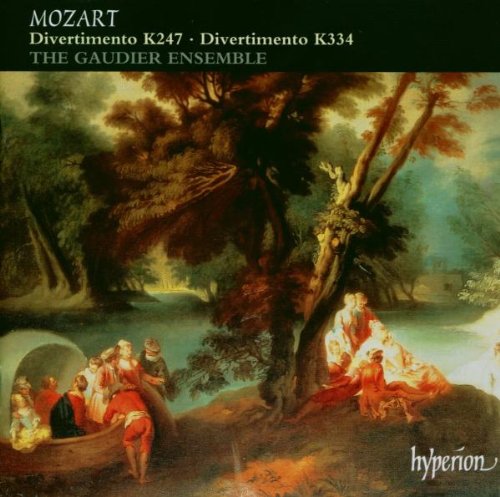Mozart Divertimenti K247 and K334
Mozart as Mozart intended, and the result is totally delectable
View record and artist detailsRecord and Artist Details
Composer or Director: Wolfgang Amadeus Mozart
Genre:
Orchestral
Label: Hyperion
Magazine Review Date: 1/2004
Media Format: CD or Download
Media Runtime: 76
Mastering:
Stereo
DDD
Catalogue Number: CDA67386

Tracks:
| Composition | Artist Credit |
|---|---|
| Divertimento No. 10 |
Wolfgang Amadeus Mozart, Composer
Gaudier Ensemble Wolfgang Amadeus Mozart, Composer |
| Divertimento No. 17 |
Wolfgang Amadeus Mozart, Composer
Gaudier Ensemble Wolfgang Amadeus Mozart, Composer |
Author: Stanley Sadie
How lucky the burghers of Salzburg, in Mozart’s day, who had such music as this to accompany their family celebrations! Or at least the rich ones. Mozart wrote a small group of divertimentos for strings and horns, for the local aristocracy (not including the archbishop, of course) during his later years there, to augment his salary and his prestige, and he did it with a mastery of technique that enabled him to find exactly the right blend of high spirits, warmth of expression and wit.
They have been recorded several times, of course, but nearly always with an orchestra rather than a solo group. In Austria, in Mozart’s time, the word ‘divertimento’ signified solo performance, and there’s a world of difference between what a sensitive solo fiddler can do with that top line and what a galumphing orchestra is able to do, in terms of technique, expressiveness and flexibility. Further, in these performances the bass part is played not by a cello but, as was preferred in Salzburg, a double bass, which provides a different relationship to the upper voices, and the one that Mozart clearly intended.
The Gaudier Ensemble catch the mood of the music perfectly. The elegant sentiment of the slow movements (there are two in each work) is happily conveyed – listen to the sweetness of violinist Marieke Blankestijn’s phrasing in the Adagio of K247 and her gentle, unassuming eloquence in that of K334. In the latter work the second violin is called on, too, for some degree of virtuosity, but it is to Blankestijn that most of the rapid and stratospheric music goes, and she copes with it in style. She also phrases the famous first minuet here gracefully. Mozart’s second minuets (each divertimento has six movements) are usually more rumbustious, with the horns prominent, and these too are heartily done, the K334 one almost too much so (and curiously they omit the second repeat in Trio 2). But altogether this is a delectable record.
They have been recorded several times, of course, but nearly always with an orchestra rather than a solo group. In Austria, in Mozart’s time, the word ‘divertimento’ signified solo performance, and there’s a world of difference between what a sensitive solo fiddler can do with that top line and what a galumphing orchestra is able to do, in terms of technique, expressiveness and flexibility. Further, in these performances the bass part is played not by a cello but, as was preferred in Salzburg, a double bass, which provides a different relationship to the upper voices, and the one that Mozart clearly intended.
The Gaudier Ensemble catch the mood of the music perfectly. The elegant sentiment of the slow movements (there are two in each work) is happily conveyed – listen to the sweetness of violinist Marieke Blankestijn’s phrasing in the Adagio of K247 and her gentle, unassuming eloquence in that of K334. In the latter work the second violin is called on, too, for some degree of virtuosity, but it is to Blankestijn that most of the rapid and stratospheric music goes, and she copes with it in style. She also phrases the famous first minuet here gracefully. Mozart’s second minuets (each divertimento has six movements) are usually more rumbustious, with the horns prominent, and these too are heartily done, the K334 one almost too much so (and curiously they omit the second repeat in Trio 2). But altogether this is a delectable record.
Explore the world’s largest classical music catalogue on Apple Music Classical.
Included with an Apple Music subscription. Download now.

Gramophone Digital Club
- Digital Edition
- Digital Archive
- Reviews Database
- Events & Offers
From £9.20 / month
Subscribe
Gramophone Club
- Print Edition
- Digital Edition
- Digital Archive
- Reviews Database
- Events & Offers
From £11.45 / month
Subscribe
If you are a library, university or other organisation that would be interested in an institutional subscription to Gramophone please click here for further information.






